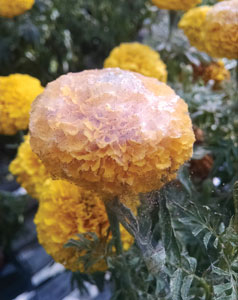10/28/2015
Growing With Griffin: Winning the War on Spider Mites
Tami Van Gaal

Growers recognize that warm, summer weather brings spider mites. However, spider mites can be present in a crop during much of the year. Spider mite populations that start small under early spring conditions can challenge many growers as the season grows warmer and conditions support a rapid population
explosion.
Additionally, certain crops tend to harbor spider mites, especially tropical foliage. If undetected, these populations can easily spread. Finally, growers may not realize that spider mites can enter diapause, a resting state, which allows pests to carryover in the greenhouse, even when crops aren’t present. We may be a long way from summer right now, but it’s never too early to arm yourself with a plan to stop this summer scourge.
Pictured: A marigold with a high two-spotted spider mite population. Notice the webbing.
Spider mite populations build in spring and summer for several reasons. First, warm temperatures favor spider mite reproduction by reducing the length of the life cycle. Second, abundant foliage combined with hot, dry weather shifts reproductive capacity into overdrive. The combination of increased reproduction with a temperature-dependent, shortened lifecycle brings population explosions. This threat calls for a strong scouting program, swift response to mite presence and a solid plan for a rotation strategy.
Manage crop nutrition. Dr. Ray Cloyd at Kansas State University notes a link between high nitrogen levels and increased spider mite populations. Most plants tolerate excessive nitrogen, so it’s not always easy to know when a crop is overfed. Avoid sending that initial invitation to the spider mites by keeping fertility levels in line and avoiding soft, lush growth. Know the nutritional requirements of your crops and conduct internal media testing to track the electrical conductivity (EC) in the media as an indicator of overall crop fertility. Outside tissue testing is also a good idea to monitor the nutritional status of crops.
Scout early, scout often. Early detection allows early control to prevent serious crop damage. Early signs of mite infection include tan or bronze spots on the upper leaf surfaces. Use a hand lens to find the associated mites on the lower leaf surfaces. Concentrate scouting on vulnerable crops and in areas with high airflow. Mandevilla, ivies, New Guinea impatiens, geraniums and ipomoea tend to be favored by spider mites. Bronzing of the entire leaf, defoliation and webbing indicate a pest explosion in progress.
Strive for IPM. Early scouting facilitates the use of softer chemistries and biological control agents (BCAs). Phytoseiulus persimilis loves to feed on spider mites and is extremely easy to use successfully. Contact your supplier to learn how to use this and other spider mite predators for effective control. Temperature, crop and pest pressure will affect the predator choice for your situation. Remember to consider chemical compatibility when using BCAs; the goal is to target the pest without disturbing the BCA population. Your BCA partner should be able to provide recommendations for compatible
products.
Plan and implement a strong rotation strategy. Spider mites currently exhibit resistance to some commonly used products and a population explosion at any time of year creates a situation ripe for developing more resistance. Growers who rotate across modes of action (MOA) experience greater success in control and help to extend the life of our most effective products. We recommend using your strongest options out of the gate to kill the highest percentage of mites and then rotate to other products to finish the job. Combine knock-down/contact products with growth regulators and change MOAs frequently. Growers are reporting success from the following products (MOAs in parentheses): Akari (21A), Floramite (UN), Kontos (23), Judo (23), Shuttle O (20B) and Sultan (25) are all good backbone products for a rotation plan. Talk to your supplier about Kontos as a drench for longer control and remember that horticultural oils remain very effective tools against mites. Contact your supplier for rotation planning and help in selecting effective products for special needs, like edible crops or open blooms. Always read and follow all label directions, paying special attention to spray water pH requirements and phyto risks (especially MOA 23). Not all pesticides are labeled for use in every state and applicators are always responsible for following the label.
Continue control into fall. A percent of mated, female spider mites present in the fall will enter diapause under most greenhouse conditions. Photoperiod, temperature and declining food sources all contribute to the start of diapause, in a process that begins when the spider mites are still immature. Spider mites entering diapause take on an orange coloration and tend to migrate downward on the plant, often lying dormant under benching. Spider mites in diapause aren’t attacked by BCAs and are more difficult to control with chemistry. Uncontrolled, these mites will become active again in the spring, laying the eggs they carried over the winter. Any pesticide resistance accumulated in the population prior to diapause may be conferred to the next generation. To avoid overwintering a mite population, it’s very important to continue your pest control into the fall. If using BCAs, consider a cleanup spray late in the season to eliminate as many spider mites as possible, thereby reducing the number of mites than can enter diapause.
Spider mites can be tough, but with a little planning and good scouting you can maintain control and the quality of your crops.
GT
Tami Van Gaal is a GGSPro Technical Support Representative for Griffin Greenhouse Supplies. She can be reached at ggsprotech@griffinmail.com.